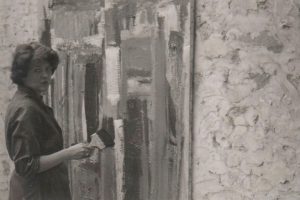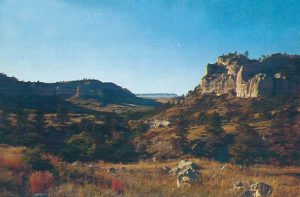LOÏS FREDERICK
Focus on an artwork

LOÏS FREDERICK
Untitled – 1969
Acrylic and gouache on paper mounted on cardboard and on stretcher
32 x 43 cm / 12.6 x 16.9 in.
Galerie Diane de Polignac, Paris
An American painter based in France, Loïs Frederick was associated with the American Colour Field painting movement, an abstract style characterised by overlaid fields of colour.
In Loïs Frederick’s work, this ‘flat’ style of painting is nonetheless solidly constructed. This abstract style, built using solid colour planes applied in layers, eliminates any impression of depth. It is the power of the brush, unfurling in a vertical movement up and down, that structures the whole work, recalling Hans Hofmann’s famous “push and pull” technique, in which the colours laid down in dense, flat fields “advance” and “recede” over the background.

Loïs Frederick in her studio, Les Audigers, c. 1960
Photo: reserved rights
The power of colour also plays a part in structuring the work and making the medium resonate. With complementary colours at play – green and orange in this 1969 work – and the use of fluorescent colours at the turn of the 1970s, the power of colour is at its peak, giving the work a dazzling luminosity, even though no yellow is used.
A native Nebraskan marked by the vast open spaces of her birthplace, as well as its continental climate and harsh light, Loïs Frederick reflected these visual shocks in her work. “Latitude: Rome. Altitude: 2700 feet. Sun, light, whatever the season. Climate of contrasts…” is how Michel Faucher described her native land.
Regardless of the medium used – canvas, or paper as in this case – or the format chosen, Loïs Frederick applied the same energy to all her works to offer us a solidly constructed form of abstract painting, a gateway to another reality, an emotional shock.
Text: Astrid de Monteverde
© Astrid de Monteverde / Diane de Polignac Gallery


